Multi-Scale Effects of Supply–Demand Changes in Water-Related Ecosystem Services Across Different Landscapes in River Basin
Abstract
:1. Introduction
2. Materials and Methods
2.1. Study Area
2.2. Data Description
2.3. Framework of This Study
2.4. Selection of the Critical WESs and Scales
2.5. Quantifying WESs Supply
2.6. Quantifying WESs Demand
2.7. Quantification of WESs Supply–Demand Change
2.8. OPGD Model and Identification of Dominant Factors
2.9. Multi-Scale Geographically Weighed Regression
3. Results
3.1. Spatial Patterns Evolution of WESs Supply–Demand Across Scales
3.2. Similarities or Discrepancies in Space Between WESs Supply–Demand Fluctuations Across Several Scales
3.3. Socioecological Driving Forces of WESs Supply–Demand Changes at Multiple Scales
3.4. The Main Forces Impacting the Supply–Demand of WESs Expressed Spatially
4. Discussion
4.1. The Supply–Demand Patterns and Connections of WESs Vary at Different Sizes
4.2. Impact of Human and Natural Factors on WESs
4.3. Policy Impacts
4.4. Comparisons with Previous Studies
4.5. Limitations and Prospects
5. Conclusions
Author Contributions
Funding
Institutional Review Board Statement
Informed Consent Statement
Data Availability Statement
Acknowledgments
Conflicts of Interest
References
- Bennett, E.M.; Baird, J.; Baulch, H.; Chaplin-Kramer, R.; Fraser, E.; Loring, P.; Morrison, P.; Parrott, L.; Sherren, K.; Winkler, K.J.; et al. Ecosystem services and the resilience of agricultural landscapes. In Advances in Ecological Research; Academic Press: Cambridge, MA, USA, 2021; Volume 64, pp. 1–43. [Google Scholar] [CrossRef]
- Zhang, C.; Li, J.; Zhou, Z. Ecosystem service cascade: Concept, review, application and prospect. Ecol. Indic. 2022, 137, 108766. [Google Scholar] [CrossRef]
- Zhang, Y.; Hu, W.; Liu, T.; Liu, F.; Li, S.; Zhang, S. Integrating ecosystem integrity and ES supply–demand process to explore ecological connectivity in Wuhan metropolitan area, China. Ecol. Indic. 2024, 163, 112128. [Google Scholar] [CrossRef]
- Jiang, W.; Tan, Y. Overview on failures of urban underground infrastructures in complex geological conditions due to heavy rainfall in China during 1994–2018. Sustain. Cities Soc. 2022, 76, 103509. [Google Scholar] [CrossRef]
- Angell, L.C.; Klassen, R.D. Integrating environmental issues into the mainstream: An agenda for research in operations management. J. Oper. Manag. 1999, 17, 575–598. [Google Scholar] [CrossRef]
- Watson, V. ‘The planned city sweeps the poor away…’: Urban planning and 21st century urbanisation. Prog. Plan. 2009, 72, 151–193. [Google Scholar] [CrossRef]
- Wu, J. Urban ecology and sustainability: The state-of-the-science and future directions. Landsc. Urban Plan. 2014, 125, 209–221. [Google Scholar] [CrossRef]
- Gao, J.; Li, F.; Gao, H.; Zhou, C.; Zhang, X. The impact of land-use change on water-related ecosystem services: A study of the Guishui River Basin, Beijing, China. J. Clean. Prod. 2017, 163, S148–S155. [Google Scholar] [CrossRef]
- Pettinotti, L.; de Ayala, A.; Ojea, E. Benefits from water related ecosystem services in Africa and climate change. Ecol. Econ. 2018, 149, 294–305. [Google Scholar] [CrossRef]
- Li, J.; Zhou, K.; Xie, B.; Xiao, J. Impact of landscape pattern change on water-related ecosystem services: Comprehensive analysis based on heterogeneity perspective. Ecol. Indic. 2021, 133, 108372. [Google Scholar] [CrossRef]
- Jiang, Y.; Ouyang, B.; Yan, Z. Multiscale Analysis for Identifying the Impact of Human and Natural Factors on Water-Related Ecosystem Services. Sustainability 2024, 16, 1738. [Google Scholar] [CrossRef]
- Spangenberg, J.H. Biodiversity pressure and the driving forces behind. Ecol. Econ. 2007, 61, 146–158. [Google Scholar] [CrossRef]
- Gobinath, R.; Ganapathy, G.P.; Gayathiri, E.; Salunkhe, A.A.; Pourghasemi, H.R. Ecoengineering practices for soil degradation protection of vulnerable hill slopes. In Computers in Earth and Environmental Sciences; Elsevier: Amsterdam, The Netherlands, 2022; pp. 255–270. [Google Scholar] [CrossRef]
- Shannon, M.A.; Bohn, P.W.; Elimelech, M.; Georgiadis, J.G.; Mariñas, B.J.; Mayes, A.M. Science and technology for water purification in the coming decades. Nature 2008, 452, 301–310. [Google Scholar] [CrossRef] [PubMed]
- Trivedi, P.; Wallenstein, M.D.; Delgado-Baquerizo, M.; Singh, B.K. Microbial modulators and mechanisms of soil carbon storage. In Soil Carbon Storage; Academic Press: Cambridge, MA, USA, 2018; pp. 73–115. [Google Scholar] [CrossRef]
- Kumar, P.; Brondizio, E.; Gatzweiler, F.; Gowdy, J.; de Groot, D.; Pascual, U.; Reyers, B.; Sukhdev, P. The economics of ecosystem services: From local analysis to national policies. Curr. Opin. Environ. Sustain. 2013, 5, 78–86. [Google Scholar] [CrossRef]
- Lyu, R.; Clarke, K.C.; Zhang, J.; Feng, J.; Jia, X.; Li, J. Spatial correlations among ecosystem services and their socio-ecological driving factors: A case study in the city belt along the Yellow River in Ningxia, China. Appl. Geogr. 2019, 108, 64–73. [Google Scholar] [CrossRef]
- Wang, L.; Chen, C.; Xie, F.; Hu, Z.; Zhang, Z.; Chen, H.; He, X.; Chu, Y. Estimation of the value of regional ecosystem services of an archipelago using satellite remote sensing technology: A case study of Zhoushan Archipelago, China. Int. J. Appl. Earth Obs. Geoinf. 2021, 105, 102616. [Google Scholar] [CrossRef]
- MacAlister, C.; Mahaxay, M. Mapping wetlands in the Lower Mekong Basin for wetland resource and conservation management using Landsat ETM images and field survey data. J. Environ. Manag. 2009, 90, 2130–2137. [Google Scholar] [CrossRef]
- Milder, J.C.; Hart, A.K.; Dobie, P.; Minai, J.; Zaleski, C. Integrated landscape initiatives for African agriculture, development, and conservation: A region-wide assessment. World Dev. 2014, 54, 68–80. [Google Scholar] [CrossRef]
- Brown, G.; Fagerholm, N. Empirical PPGIS/PGIS mapping of ecosystem services: A review and evaluation. Ecosyst. Serv. 2015, 13, 119–133. [Google Scholar] [CrossRef]
- Jain, M.; Korzhenevych, A.; Basu, A.M. Integrating spatial development with infrastructure provision along an envisioned transport corridor: A conceptual framework and its application to India. Land Use Policy 2021, 104, 105364. [Google Scholar] [CrossRef]
- Wang, J.; Zhai, T.; Lin, Y.; Kong, X.; He, T. Spatial imbalance and changes in supply and demand of ecosystem services in China. Sci. Total Environ. 2019, 657, 781–791. [Google Scholar] [CrossRef]
- Guan, Q.; Hao, J.; Ren, G.; Li, M.; Chen, A.; Duan, W.; Chen, H. Ecological indexes for the analysis of the spatial–temporal characteristics of ecosystem service supply and demand: A case study of the major grain-producing regions in Quzhou, China. Ecol. Indic. 2020, 108, 105748. [Google Scholar] [CrossRef]
- Xu, Z.; Wei, H.; Dong, X.; Liu, Y.; Xue, H. Evaluating the ecological benefits of plantations in arid areas from the perspective of ecosystem service supply and demand-based on emergy analysis. Sci. Total Environ. 2020, 705, 135853. [Google Scholar] [CrossRef]
- Sun, X.; Tang, H.; Yang, P.; Hu, G.; Liu, Z.; Wu, J. Spatiotemporal patterns and drivers of ecosystem service supply and demand across the conterminous United States: A multiscale analysis. Sci. Total Environ. 2020, 703, 135005. [Google Scholar] [CrossRef] [PubMed]
- Xu, X.; Chen, M.; Yang, G.; Jiang, B.; Zhang, J. Wetland ecosystem services research: A critical review. Glob. Ecol. Conserv. 2020, 22, e01027. [Google Scholar] [CrossRef]
- Zhu, Z.; Wang, K.; Lei, M.; Li, X.; Li, X.; Jiang, L.; Gao, X.; Li, S.; Liang, J. Identification of priority areas for water ecosystem services by a techno-economic, social and climate change modeling framework. Water Res. 2022, 221, 118766. [Google Scholar] [CrossRef]
- McNie, E.C. Reconciling the supply of scientific information with user demands: An analysis of the problem and review of the literature. Environ. Sci. Policy 2007, 10, 17–38. [Google Scholar] [CrossRef]
- Sorrell, S. Reducing energy demand: A review of issues, challenges and approaches. Renew. Sustain. Energy Rev. 2015, 47, 74–82. [Google Scholar] [CrossRef]
- Xu, Z.; Peng, J.; Dong, J.; Liu, Y.; Liu, Q.; Lyu, D.; Qiao, R.; Zhang, Z. Spatial correlation between the changes of ecosystem service supply and demand: An ecological zoning approach. Landsc. Urban Plan. 2022, 217, 104258. [Google Scholar] [CrossRef]
- Mereta, S.T.; Boets, P.; Bayih, A.A.; Malu, A.; Ephrem, Z.; Sisay, A.; Endale, H.; Yitbarek, M.; Jemal, A.; De Meester, L.; et al. Analysis of environmental factors determining the abundance and diversity of macroinvertebrate taxa in natural wetlands of Southwest Ethiopia. Ecol. Inform. 2012, 7, 52–61. [Google Scholar] [CrossRef]
- Li, J.; Xie, B.; Gao, C.; Zhou, K.; Liu, C.; Zhao, W.; Xiao, J.; Xie, J. Impacts of natural and human factors on water-related ecosystem services in the Dongting Lake Basin. J. Clean. Prod. 2022, 370, 133400. [Google Scholar] [CrossRef]
- Saleth, R.M.; Dinar, A. Institutional changes in global water sector: Trends, patterns, and implications. Water Policy 2000, 2, 175–199. [Google Scholar] [CrossRef]
- Goldman, M. How “Water for All!” policy became hegemonic: The power of the World Bank and its transnational policy networks. Geoforum 2007, 38, 786–800. [Google Scholar] [CrossRef]
- Ison, R.; Röling, N.; Watson, D. Challenges to science and society in the sustainable management and use of water: Investigating the role of social learning. Environ. Sci. Policy 2007, 10, 499–511. [Google Scholar] [CrossRef]
- Green, B. The flaws of policies requiring human oversight of government algorithms. Comput. Law Secur. Rev. 2022, 45, 105681. [Google Scholar] [CrossRef]
- Geijzendorffer, I.R.; Martín-López, B.; Roche, P.K. Improving the identification of mismatches in ecosystem services assessments. Ecol. Indic. 2015, 52, 320–331. [Google Scholar] [CrossRef]
- Yang, S.; Bai, Y.; Alatalo, J.M.; Wang, H.; Jiang, B.; Liu, G.; Chen, J. Spatio-temporal changes in water-related ecosystem services provision and trade-offs with food production. J. Clean. Prod. 2021, 286, 125316. [Google Scholar] [CrossRef]
- Wang, Y.; Wang, H.; Zhang, J.; Liu, G.; Fang, Z.; Wang, D. Exploring interactions in water-related ecosystem services nexus in Loess Plateau. J. Environ. Manag. 2023, 336, 117550. [Google Scholar] [CrossRef] [PubMed]
- Bagstad, K.J.; Johnson, G.W.; Voigt, B.; Villa, F. Spatial dynamics of ecosystem service flows: A comprehensive approach to quantifying actual services. Ecosyst. Serv. 2013, 4, 117–125. [Google Scholar] [CrossRef]
- He, G.; Zhang, L.; Wei, X.; Jin, G. Scale effects on the supply–demand mismatches of ecosystem services in Hubei Province, China. Ecol. Indic. 2023, 153, 110461. [Google Scholar] [CrossRef]
- Xue, C.; Xue, L.; Chen, J.; Tarolli, P.; Chen, X.; Zhang, H.; Qian, J.; Zhou, Y.; Liu, X. Understanding driving mechanisms behind the supply-demand pattern of ecosystem services for land-use administration: Insights from a spatially explicit analysis. J. Clean. Prod. 2023, 427, 139239. [Google Scholar] [CrossRef]
- Baró, F.; Haase, D.; Gómez-Baggethun, E.; Frantzeskaki, N. Mismatches between ecosystem services supply and demand in urban areas: A quantitative assessment in five European cities. Ecol. Indic. 2015, 55, 146–158. [Google Scholar] [CrossRef]
- Liu, H.; Xiao, W.; Zhu, J.; Zeng, L.; Li, Q. Urbanization intensifies the mismatch between the supply and demand of regional ecosystem services: A large-scale case of the Yangtze River Economic Belt in China. Remote Sens. 2022, 14, 5147. [Google Scholar] [CrossRef]
- Wang, L.J.; Gong, J.W.; Ma, S.; Wu, S.; Zhang, X.; Jiang, J. Ecosystem service supply–demand and socioecological drivers at different spatial scales in Zhejiang Province, China. Ecol. Indic. 2022, 140, 109058. [Google Scholar] [CrossRef]
- Qi, F.; Liu, J.; Gao, H.; Fu, T.; Wang, F. Characteristics and spatial–temporal patterns of supply and demand of ecosystem services in the Taihang Mountains. Ecol. Indic. 2023, 147, 109932. [Google Scholar] [CrossRef]
- Sarstedt, M.; Ringle, C.M.; Hair, J.F. Partial least squares structural equation modeling. In Handbook of Market Research; Springer International Publishing: Cham, Switzerland, 2021; pp. 587–632. [Google Scholar] [CrossRef]
- Li, M.; Abuduwaili, J.; Liu, W.; Feng, S.; Saparov, G.; Ma, L. Application of geographical detector and geographically weighted regression for assessing landscape ecological risk in the Irtysh River Basin, Central Asia. Ecol. Indic. 2024, 158, 111540. [Google Scholar] [CrossRef]
- Zargari, S.A.; Khorshidi, N.A.; Mirzahossein, H.; Heidari, H. Analyzing the effects of congestion on planning time index–Grey models vs. random forest regression. Int. J. Transp. Sci. Technol. 2023, 12, 578–593. [Google Scholar] [CrossRef]
- Zhu, L.; Meng, J.; Zhu, L. Applying Geodetector to disentangle the contributions of natural and anthropogenic factors to NDVI variations in the middle reaches of the Heihe River Basin. Ecol. Indic. 2020, 117, 106545. [Google Scholar] [CrossRef]
- Anchang, J.Y.; Ananga, E.O.; Pu, R. An efficient unsupervised index based approach for mapping urban vegetation from IKONOS imagery. Int. J. Appl. Earth Obs. Geoinf. 2016, 50, 211–220. [Google Scholar] [CrossRef]
- Zhao, X.; Tan, S.; Li, Y.; Wu, H.; Wu, R. Quantitative analysis of fractional vegetation cover in southern Sichuan urban agglomeration using optimal parameter geographic detector model, China. Ecol. Indic. 2024, 158, 111529. [Google Scholar] [CrossRef]
- Jiang, H.; Hu, H.; Li, B.; Zhang, Z.; Wang, S.; Lin, T. Understanding the non-stationary relationships between corn yields and meteorology via a spatiotemporally varying coefficient model. Agric. For. Meteorol. 2021, 301, 108340. [Google Scholar] [CrossRef]
- Wang, J.; Wang, S.; Li, S. Examining the spatially varying effects of factors on PM2.5 concentrations in Chinese cities using geographically weighted regression modeling. Environ. Pollut. 2019, 248, 792–803. [Google Scholar] [CrossRef] [PubMed]
- Gao, Y.; Zhao, J.; Han, L. Exploring the spatial heterogeneity of urban heat island effect and its relationship to block morphology with the geographically weighted regression model. Sustain. Cities Soc. 2022, 76, 103431. [Google Scholar] [CrossRef]
- Punzo, G.; Castellano, R.; Bruno, E. Using geographically weighted regressions to explore spatial heterogeneity of land use influencing factors in Campania (Southern Italy). Land Use Policy 2022, 112, 105853. [Google Scholar] [CrossRef]
- Miller, J.; Franklin, J.; Aspinall, R. Incorporating spatial dependence in predictive vegetation models. Ecol. Model. 2007, 202, 225–242. [Google Scholar] [CrossRef]
- Yang, H.; Feng, Q.; Zhu, J.; Liu, G.; Dai, Y.; Zhou, Q.; Xia, S.; Wu, Z.; Zhang, Y. Towards sustainable futures: A review of sediment remediation and resource valorization techniques. J. Clean. Prod. 2024, 3, 140529. [Google Scholar] [CrossRef]
- Zhang, K.; Yang, X.; Xu, M.; Lin, Q.; Kattel, G.; Shen, J. Confronting challenges of managing degraded lake ecosystems in the Anthropocene, exemplified from the Yangtze River Basin in China. Anthropocene 2018, 24, 30–39. [Google Scholar] [CrossRef]
- Li, P.; Yu, Z.; Jiang, P.; Wu, C. Spatiotemporal characteristics of regional extreme precipitation in Yangtze River basin. J. Hydrol. 2021, 603, 126910. [Google Scholar] [CrossRef]
- McConnachie, M.M.; Shackleton, C.M.; McGregor, G.K. The extent of public green space and alien plant species in 10 small towns of the Sub-Tropical Thicket Biome, South Africa. Urban For. Urban Green. 2008, 7, 1–3. [Google Scholar] [CrossRef]
- Guan, Y.; Zhang, X.; Zheng, F.; Wang, B. Trends and variability of daily temperature extremes during 1960–2012 in the Yangtze River Basin, China. Glob. Planet. Chang. 2015, 124, 79–94. [Google Scholar] [CrossRef]
- Green, P.A.; Vörösmarty, C.J.; Harrison, I.; Farrell, T.; Sáenz, L.; Fekete, B.M. Freshwater ecosystem services supporting humans: Pivoting from water crisis to water solutions. Glob. Environ. Chang. 2015, 34, 108–118. [Google Scholar] [CrossRef]
- Davies, J.M.; Mazumder, A. Health and environmental policy issues in Canada: The role of watershed management in sustaining clean drinking water quality at surface sources. J. Environ. Manag. 2003, 68, 273–286. [Google Scholar] [CrossRef] [PubMed]
- Sandifer, P.A.; Sutton-Grier, A.E.; Ward, B.P. Exploring connections among nature, biodiversity, ecosystem services, and human health and well-being: Opportunities to enhance health and biodiversity conservation. Ecosyst. Serv. 2015, 12, 1–5. [Google Scholar] [CrossRef]
- Hou, Y.; Li, B.; Müller, F.; Fu, Q.; Chen, W. A conservation decision-making framework based on ecosystem service hotspot and interaction analyses on multiple scales. Sci. Total Environ. 2018, 643, 277–291. [Google Scholar] [CrossRef] [PubMed]
- Yang, S.; Pan, Z.; Lou, H.; Li, C.; Zhang, J.; Zhang, Y.; Yi, Y.; Gong, J.; Luo, Y.; Zhi, M.; et al. Reconstruction of the water cycle process reveals the 600-year evolution of the human-water relationship in Tunpu, China. J. Hydrol. 2023, 617, 128927. [Google Scholar] [CrossRef]
- Cai, G.; Xiong, J.; Wen, L.; Weng, A.; Lin, Y.; Li, B. Predicting the ecosystem service values and constructing ecological security patterns in future changing land use patterns. Ecol. Indic. 2023, 154, 110787. [Google Scholar] [CrossRef]
- Pan, X.; Xu, L.; Yang, Z.; Yu, B. Payments for ecosystem services in China: Policy, practice, and progress. J. Clean. Prod. 2017, 158, 200–208. [Google Scholar] [CrossRef]
- Li, Z.; Ning, K.; Chen, J.; Liu, C.; Wang, D.; Nie, X.; Hu, X.; Wang, L.; Wang, T. Soil and water conservation effects driven by the implementation of ecological restoration projects: Evidence from the red soil hilly region of China in the last three decades. J. Clean. Prod. 2020, 260, 121109. [Google Scholar] [CrossRef]
- Liu, T.; Yu, L.; Chen, X.; Wu, H.; Lin, H.; Li, C.; Hou, J. Environmental laws and ecological restoration projects enhancing ecosystem services in China: A meta-analysis. J. Environ. Manag. 2023, 327, 116810. [Google Scholar] [CrossRef]
- Link, J.S.; Ihde, T.F.; Harvey, C.J.; Gaichas, S.K.; Field, J.C.; Brodziak, J.K.; Townsend, H.M.; Peterman, R.M. Dealing with uncertainty in ecosystem models: The paradox of use for living marine resource management. Prog. Oceanogr. 2012, 102, 102–114. [Google Scholar] [CrossRef]
- Stefanidis, S.; Proutsos, N.; Alexandridis, V.; Mallinis, G. Ecosystem Services Supply from Peri-Urban Watersheds in Greece: Soil Conservation and Water Retention. Land 2024, 13, 765. [Google Scholar] [CrossRef]
- Schulte-Hostedde, B.; Walters, D.; Powell, C.; Shrubsole, D. Wetland management: An analysis of past practice and recent policy changes in Ontario. J. Environ. Manag. 2007, 82, 83–94. [Google Scholar] [CrossRef] [PubMed]
- Westerink, J.; Jongeneel, R.; Polman, N.; Prager, K.; Franks, J.; Dupraz, P.; Mettepenningen, E. Collaborative governance arrangements to deliver spatially coordinated agri-environmental management. Land Use Policy 2017, 69, 176–192. [Google Scholar] [CrossRef]
- Rezaei, S.; Behrens, T.G. Spatial analysis of transportation networks: A review of methods and tools. J. Transp. Geography. 2014, 28, 144–157. [Google Scholar] [CrossRef]
- Fletcher, R.J.; McCleery, R.A.; Greene, D.U.; Tye, C.A. Integrated models that unite local and regional data reveal larger-scale environmental relationships and improve predictions of species distributions. Landsc. Ecol. 2016, 31, 1369–1382. [Google Scholar] [CrossRef]
- Ørka, H.O.; Jutras-Perreault, M.C.; Næsset, E.; Gobakken, T. A framework for a forest ecological base map–an example from Norway. Ecol. Indic. 2022, 136, 108636. [Google Scholar] [CrossRef]
- Zhao, S.; Liu, Y.; Zhang, R.; Fu, B. China’s population spatialization based on three machine learning models. J. Clean. Prod. 2020, 256, 120644. [Google Scholar] [CrossRef]
- Wan, H.; Ganguli, S.; Jain, M.; Anderson, D.; Mohankumar, N.M.; Wilson, K. Areal interpolation of population projections consistent with different SSPs from 1-km resolution to block level based on USA Structures dataset. Comput. Environ. Urban Syst. 2023, 105, 102024. [Google Scholar] [CrossRef]
- Casagrande, E.; Recanati, F.; Rulli, M.C.; Bevacqua, D.; Melia, P. Water balance partitioning for ecosystem service assessment. A case study in the Amazon. Ecol. Indic. 2021, 121, 107155. [Google Scholar] [CrossRef]
- Zhao, J.; Yang, Z.; Govers, G. Soil and water conservation measures reduce soil and water losses in China but not down to background levels: Evidence from erosion plot data. Geoderma 2019, 337, 729–741. [Google Scholar] [CrossRef]
- Li, C.; Jiang, T.T.; Luan, X.B.; Yin, Y.L.; Wu, P.T.; Wang, Y.B.; Sun, S.K. Determinants of agricultural water demand in China. J. Clean. Prod. 2021, 288, 125508. [Google Scholar] [CrossRef]
- Li, T.; Wang, H.; Fang, Z.; Liu, G.; Zhang, F.; Zhang, H.; Li, X. Integrating river health into the supply and demand management framework for river basin ecosystem services. Sustain. Prod. Consum. 2022, 33, 189–202. [Google Scholar] [CrossRef]
- Mahboubi, P.; Parkes, M.; Stephen, C.; Chan, H.M. Using expert informed GIS to locate important marine social-ecological hotspots. J. Environ. Manag. 2015, 160, 342–352. [Google Scholar] [CrossRef] [PubMed]
- Xu, H.; Croot, P.; Zhang, C. Discovering hidden spatial patterns and their associations with controlling factors for potentially toxic elements in topsoil using hot spot analysis and K-means clustering analysis. Environ. Int. 2021, 151, 106456. [Google Scholar] [CrossRef]
- He, Q.; Yan, M.; Zheng, L.; Wang, B. Spatial stratified heterogeneity and driving mechanism of urban development level in China under different urban growth patterns with optimal parameter-based geographic detector model mining. Comput. Environ. Urban Syst. 2023, 105, 102023. [Google Scholar] [CrossRef]
- Tsai, C.J.; Lee, C.I.; Yang, W.P. A discretization algorithm based on class-attribute contingency coefficient. Inf. Sci. 2008, 178, 714–731. [Google Scholar] [CrossRef]
- Luo, T.; Zeng, J.; Chen, W.; Wang, Y.; Gu, T.; Huang, C. Ecosystem services balance and its influencing factors detection in China: A case study in Chengdu-Chongqing urban agglomerations. Ecol. Indic. 2023, 151, 110330. [Google Scholar] [CrossRef]
- Jiang, Y.; Ouyang, B.; Yan, Z. Spatial Correlation between the Changes in Supply and Demand for Water-Related Ecosystem Services. ISPRS Int. J. Geo-Inf. 2024, 13, 68. [Google Scholar] [CrossRef]
- Li, Z.; Quiring, S.M. Investigating spatial heterogeneity of the controls of surface water balance in the contiguous United States by considering anthropogenic factors. J. Hydrol. 2021, 601, 126621. [Google Scholar] [CrossRef]
- Liu, C.; He, N.P.; Zhang, J.H.; Li, Y.; Wang, Q.F.; Sack, L.; Yu, G.R. Variation of stomatal traits from cold temperate to tropical forests and association with water use efficiency. Funct. Ecol. 2018, 32, 20–28. [Google Scholar] [CrossRef]
- Song, Y.; Wang, J.; Ge, Y.; Xu, C. An optimal parameters-based geographical detector model enhances geographic characteristics of explanatory variables for spatial heterogeneity analysis: Cases with different types of spatial data. GIScience Remote Sens. 2020, 57, 593–610. [Google Scholar] [CrossRef]
- Zhang, Z.; Song, Y.; Archer, N.; Wu, P. Spatial disparity of urban performance from a scaling perspective: A study of industrial features associated with economy, infrastructure, and innovation. GIScience Remote Sens. 2023, 60, 2167567. [Google Scholar] [CrossRef]
- Wu, J.; Wang, G.; Chen, W.; Pan, S.; Zeng, J. Terrain gradient variations in the ecosystem services value of the Qinghai-Tibet Plateau, China. Glob. Ecol. Conserv. 2022, 34, e02008. [Google Scholar] [CrossRef]
- Thenkabail, P.S.; Lyon, J.; Huete, A. Hyperspectral vegetation indices and their relationships with agricultural crop characteristics. Remote Sens. Environ. 2016, 152, 159–179. [Google Scholar] [CrossRef]
- Zhu, Z.; Woodcock, C.E. Continuous field of tree crowns using multiple-view stereo and hyperspectral data. Remote Sens. Environ. 2014, 145, 135–145. [Google Scholar] [CrossRef]
- Maestas, N.; Mullen, K.J.; Powell, D. The effect of population aging on economic growth, the labor force, and productivity. Am. Econ. J. Macroecon. 2023, 15, 306–332. [Google Scholar] [CrossRef]
- Gaur, S.; Singh, R. A Comprehensive Review on Land Use/Land Cover (LULC) Change Modeling for Urban Development: Current Status and Future Prospects. Sustainability 2023, 15, 903. [Google Scholar] [CrossRef]
- Shi, P.; Ge, F. A comparison of different thermal performance functions describing temperature-dependent development rates. J. Therm. Biol. 2010, 35, 225–231. [Google Scholar] [CrossRef]
- Cao, Y.; DeWalt, R.E.; Robinson, J.L.; Tweddale, T.; Hinz, L.; Pessino, M. Using Maxent to model the historic distributions of stonefly species in Illinois streams: The effects of regularization and threshold selections. Ecol. Model. 2013, 259, 30–39. [Google Scholar] [CrossRef]
- Cushman, S.A.; McGarigal, K.; Neel, M.C. Parsimony in landscape metrics: Strength, universality, and consistency. Ecol. Indic. 2008, 8, 691–703. [Google Scholar] [CrossRef]
- Jarrah, M.; Mayel, S.; Tatarko, J.; Funk, R.; Kuka, K. A review of wind erosion models: Data requirements, processes, and validity. Catena 2020, 187, 104388. [Google Scholar] [CrossRef]
- Baró, F.; Gómez-Baggethun, E.; Haase, D. Ecosystem service bundles along the urban-rural gradient: Insights for landscape planning and management. Ecosyst. Serv. 2017, 24, 147–159. [Google Scholar] [CrossRef]
- Liu, S.; Ma, L.; Yao, Y.; Cui, X. Man-land relationship based on the spatial coupling of population and residential land–A case study of Yuzhong County in Longzhong Loess Hilly Region, China. Land Use Policy 2022, 116, 106059. [Google Scholar] [CrossRef]
- Amara-Ouali, Y.; Fasiolo, M.; Goude, Y.; Yan, H. Daily peak electrical load forecasting with a multi-resolution approach. Int. J. Forecast. 2023, 39, 1272–1286. [Google Scholar] [CrossRef]
- Wang, S.; Liu, Z.; Chen, Y.; Fang, C. Factors influencing ecosystem services in the Pearl River Delta, China: Spatiotemporal differentiation and varying importance. Resour. Conserv. Recycl. 2021, 168, 105477. [Google Scholar] [CrossRef]
- Chen, Z.; Wang, W.; Forzieri, G.; Cescatti, A. Transition from positive to negative indirect CO2 effects on the vegetation carbon uptake. Nat. Commun. 2024, 15, 1500. [Google Scholar] [CrossRef] [PubMed]
- Wu, D.; Zheng, L.; Wang, Y.; Gong, J.; Li, J.; Chen, Q. Characteristics of urban expansion in megacities and its impact on water-related ecosystem services: A comparative study of Chengdu and Wuhan, China. Ecol. Indic. 2024, 158, 111322. [Google Scholar] [CrossRef]
- Birk, S.; Chapman, D.; Carvalho, L.; Spears, B.M.; Andersen, H.E.; Argillier, C.; Auer, S.; Baattrup-Pedersen, A.; Banin, L.; Beklioğlu, M.; et al. Impacts of multiple stressors on freshwater biota across spatial scales and ecosystems. Nat. Ecol. Evol. 2020, 4, 1060–1068. [Google Scholar] [CrossRef]
- Xu, Y.; Lu, Y.G.; Zou, B.; Xu, M.; Feng, Y.X. Unraveling the enigma of NPP variation in Chinese vegetation ecosystems: The interplay of climate change and land use change. Sci. Total Environ. 2024, 912, 169023. [Google Scholar] [CrossRef] [PubMed]
- Fang, Z.; Ding, T.; Chen, J.; Xue, S.; Zhou, Q.; Wang, Y.; Wang, Y.; Huang, Z.; Yang, S. Impacts of land use/land cover changes on ecosystem services in ecologically fragile regions. Sci. Total Environ. 2022, 831, 154967. [Google Scholar] [CrossRef]
- Zhou, Y.; Li, Y.; Liu, Y. The nexus between regional eco-environmental degradation and rural impoverishment in China. Habitat Int. 2020, 96, 102086. [Google Scholar] [CrossRef]


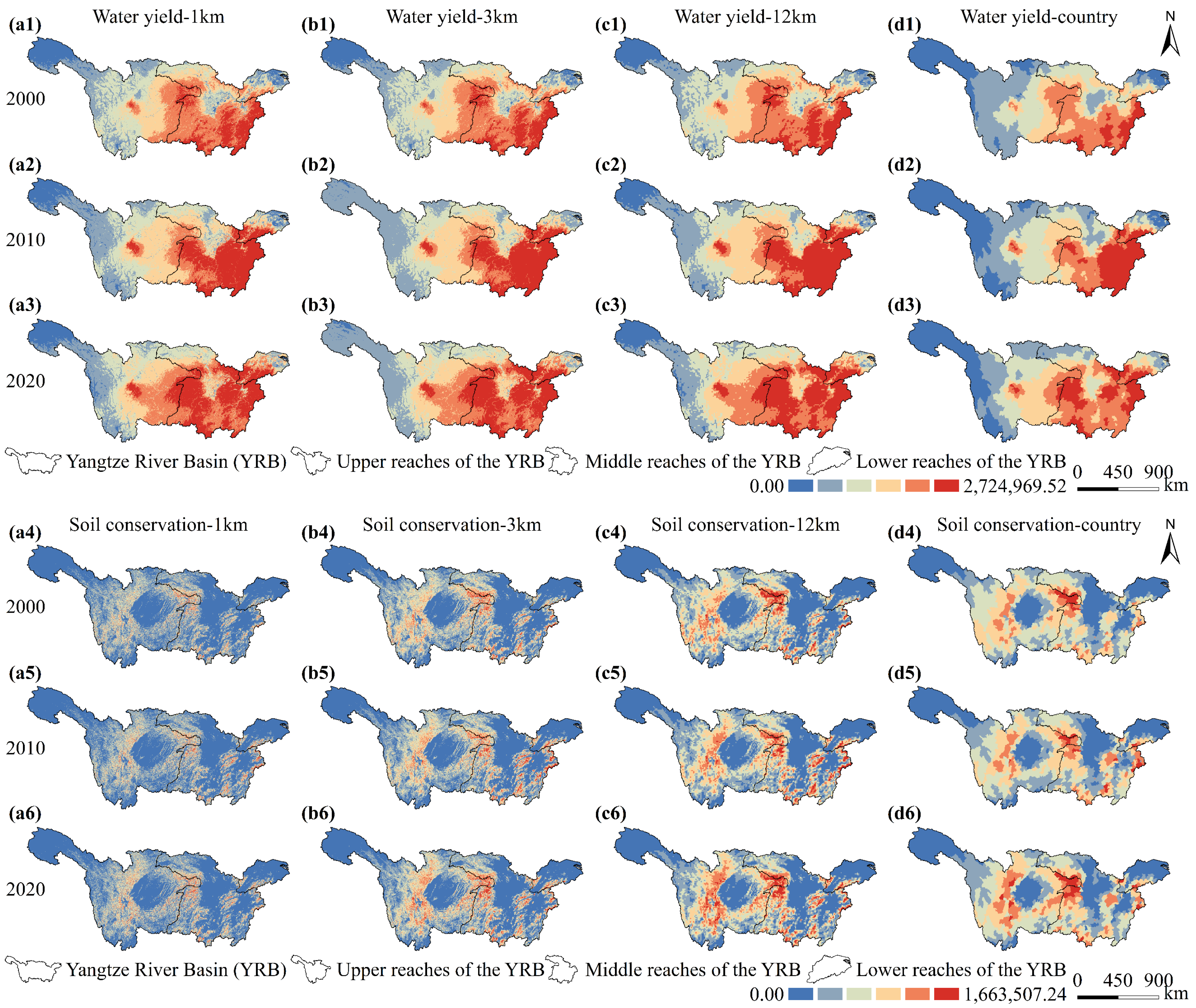

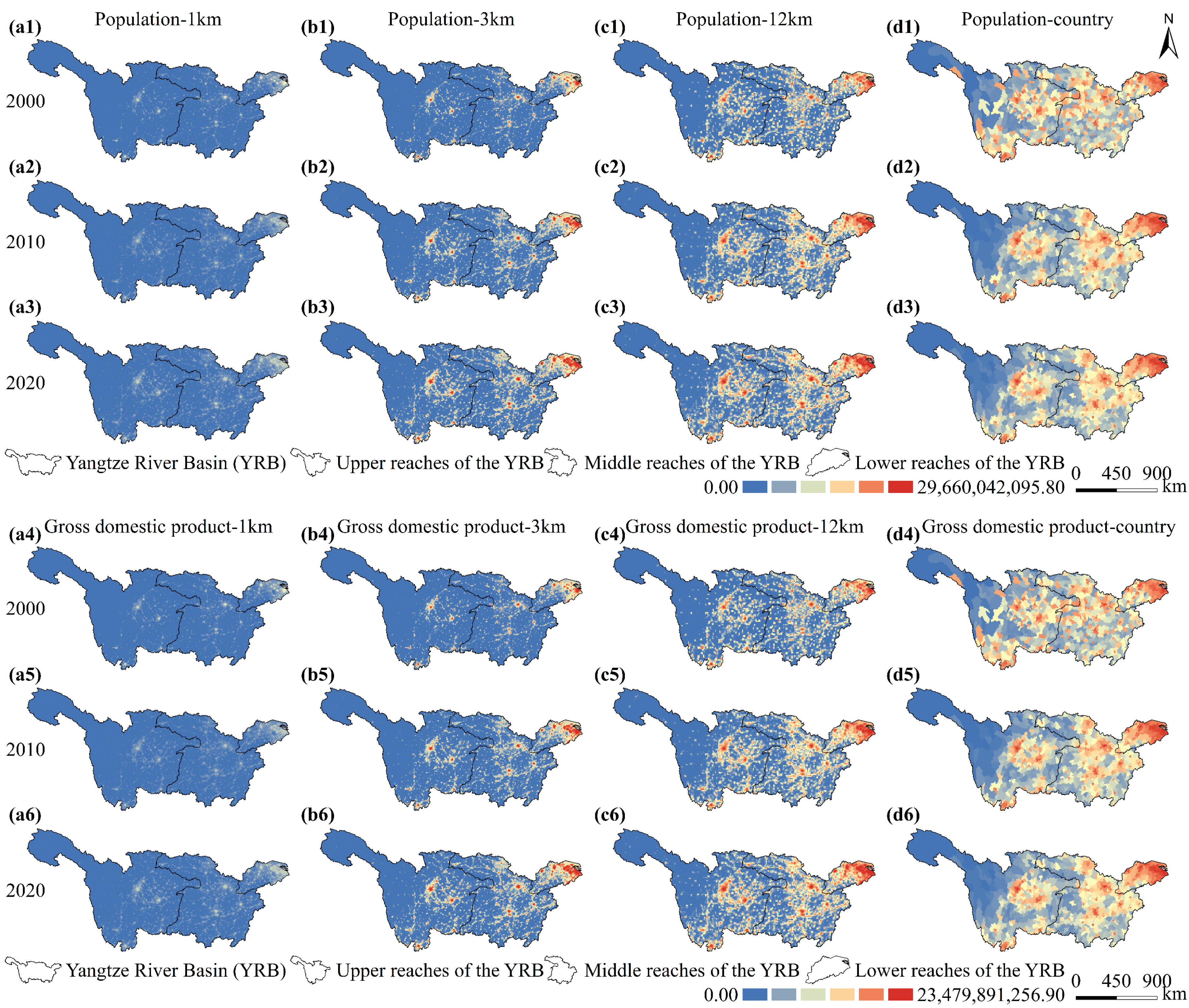
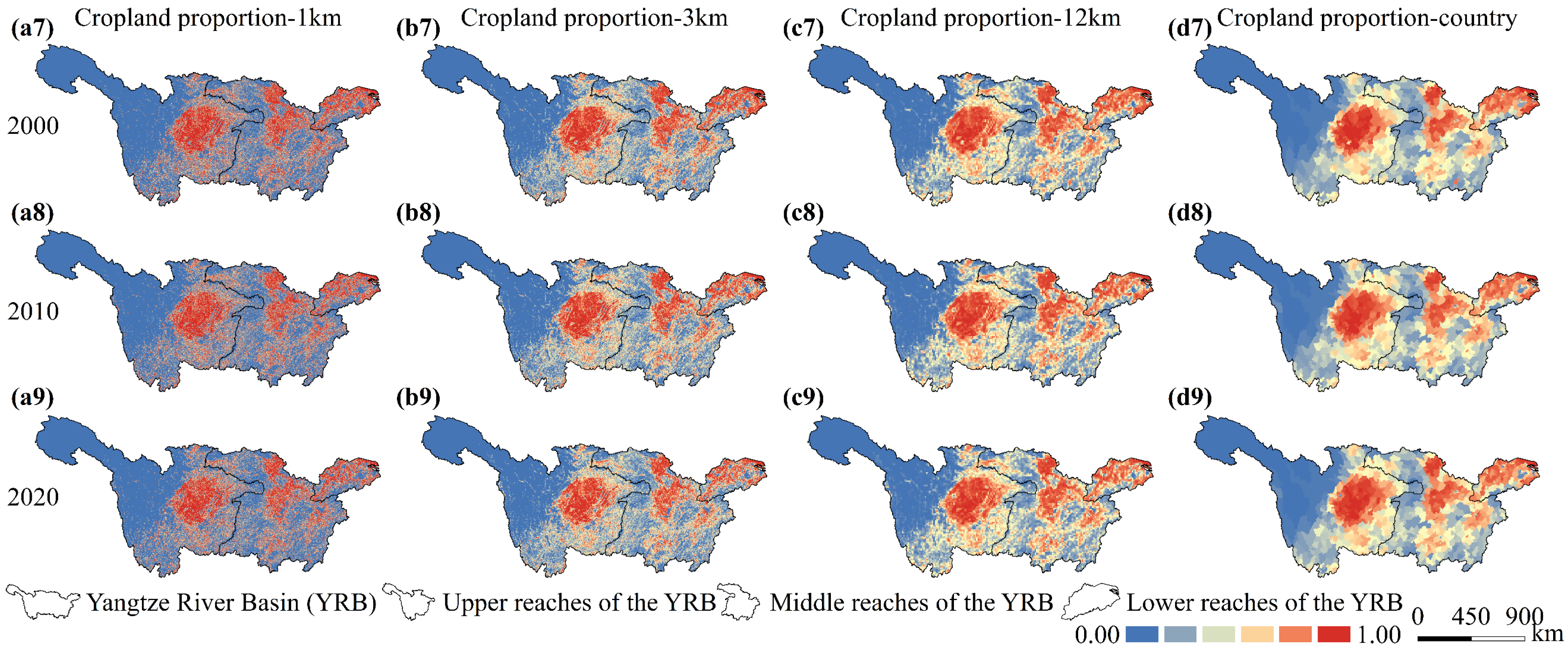
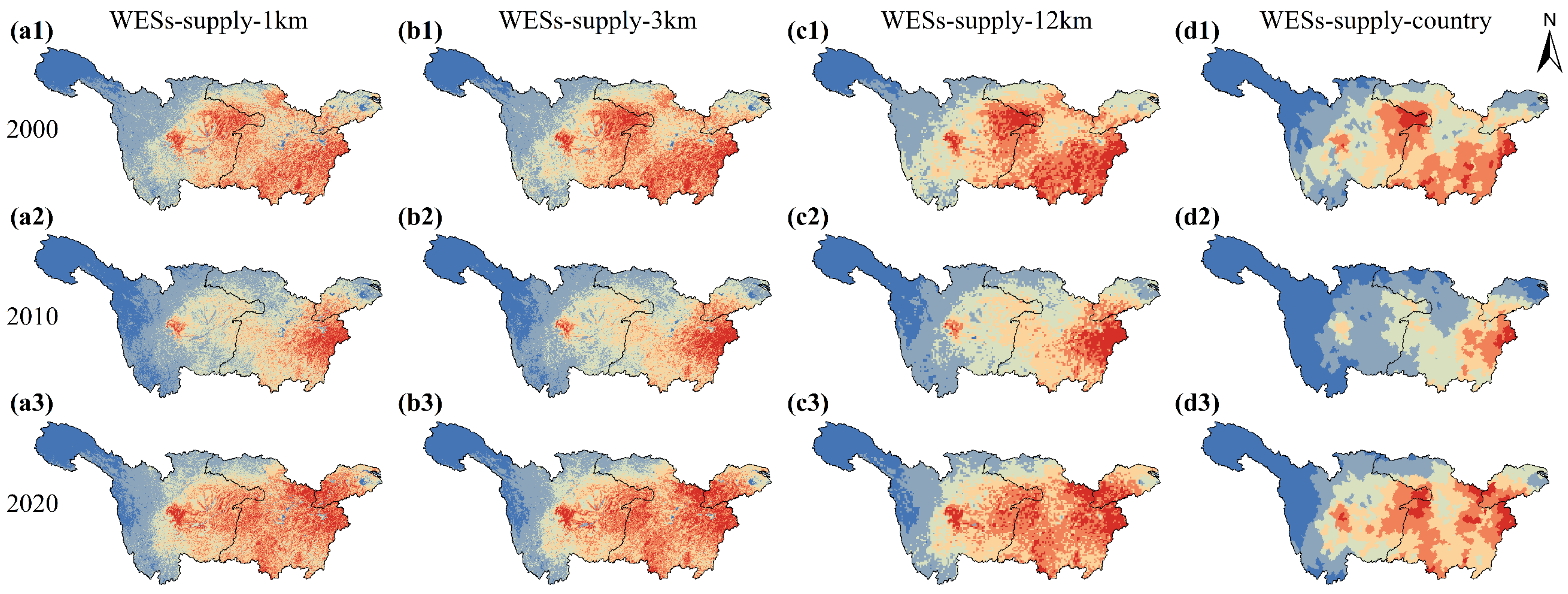
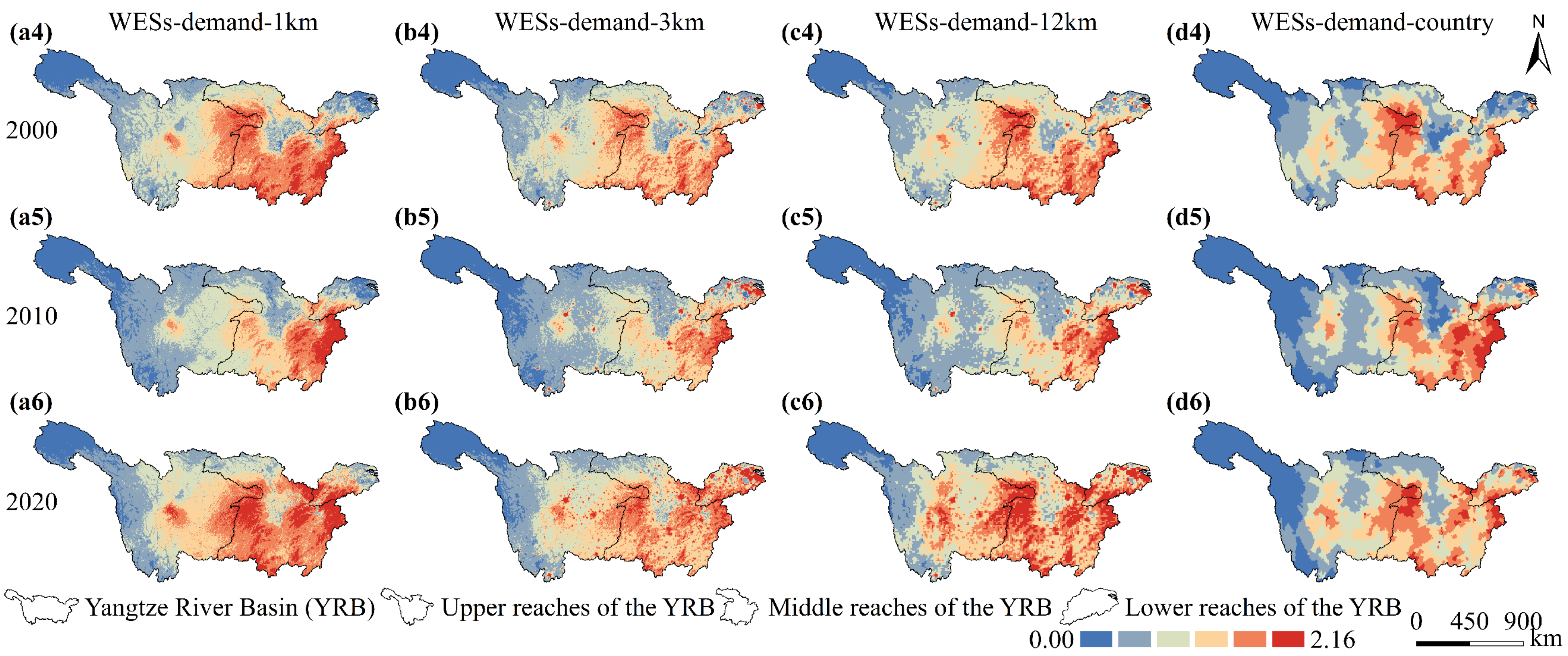


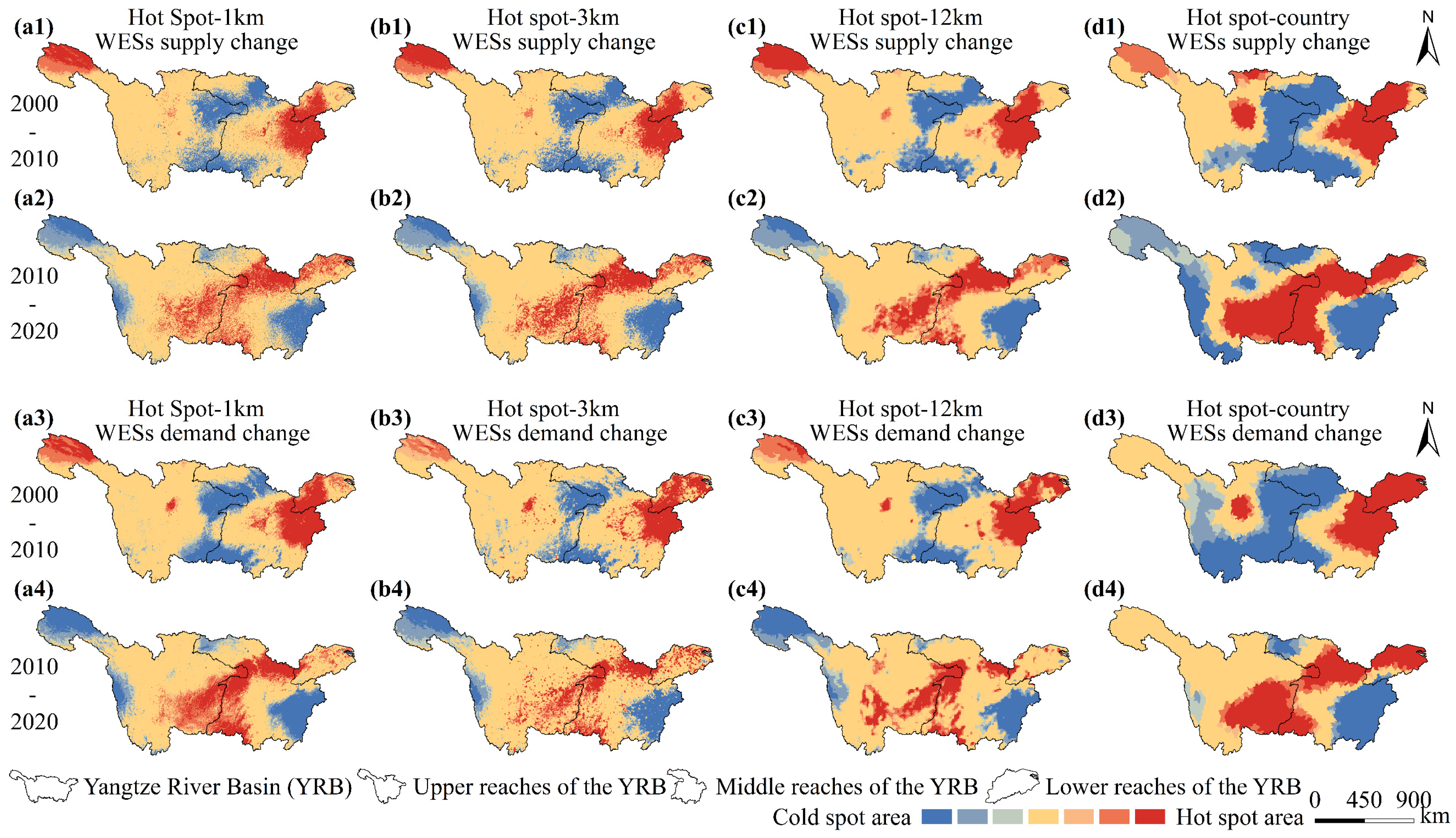


| Data Type | Period | Spatial Resolution | Data Sources |
|---|---|---|---|
| LULC data | 2000, 2010, 2020 | 30 m | Resource and Environment Science and Data Centre (RESDC, http://www.resdc.cn/, DOI: 10.12078/2018070201), accessed on 3 April 2024 |
| Digital elevation model (DEM) | — | 30 m | Geospatial data cloud platform (http://www.gscloud.cn/), accessed on 4 April 2024 |
| Slope | — | 30 m | Using DEM data, the required terrain information was extracted through ArcGIS 10.6.1 software. Accessed on 3 March 2024 |
| Soil data | — | 1 km | RESDC |
| Meteorological data (temperature, precipitation, evapotranspiration) | 2000, 2010, 2020 | 1 km | China Daily Surface Climate dataset (V3.0) (http://data.cma.cn), accessed on 3 April 2024 |
| Normalized difference vegetation index (NDVI) | 2000, 2010, 2020 | 250 m | https://modis.gsfc.nasa.gov/data/, accessed on 21 March 2024 |
| Nighttime-light dataset | 2000, 2010, 2020 | 1 km | https://data.tpdc.ac.cn/, accessed on 19 March 2024 |
| Population | 2000, 2010, 2020 | 1 km | Statistical Yearbook in China, accessed on 12 March 2024 |
| Gross domestic product (GDP) | 2000, 2010, 2020 | 1 km | Statistical Yearbook in China, accessed on 12 March 2024 |
| Water consumption | 2000, 2010, 2020 | — | Water resources bulletin, accessed on 12 March 2024 |
| Types | Sub-Types | Driving Factors | Code |
|---|---|---|---|
| Ecological factors | Terrain | Average elevation (m) | DEM |
| Terrain slope | Slope | ||
| Meteorological | Annual average precipitation (mm) | PRE | |
| Annual average temperature (mm) | TEM | ||
| Vegetation | Normalized differential vegetation index | NDVI | |
| Social factors | Population | Population density (person/km2) | POP |
| Economy | Economic density (104 yuan/km2) | GDP | |
| Land use and land cover type | Forest land proportion (%) | FLP | |
| Construction land proportion (%) | COP | ||
| Water bodies proportion (%) | WBP |
| Scale | 1 km | 3 km | 12 km | County | ||||
|---|---|---|---|---|---|---|---|---|
| Year | 2000–2010 | 2010–2020 | 2000–2010 | 2010–2020 | 2000–2010 | 2010–2020 | 2000–2010 | 2010–2020 |
| Pre | 0.3190 | 0.4087 | 0.2993 | 0.3992 | 0.2458 | 0.3572 | 0.2094 | 0.2523 |
| Tem | 0.1492 | 0.1643 | 0.1972 | 0.2868 | 0.2266 | 0.3235 | 0.1785 | 0.2077 |
| Ndvi | 0.1182 | 0.1326 | 0.1192 | 0.1337 | 0.1581 | 0.1725 | 0.0879 | 0.1095 |
| Cop | 0.0014 | 0.0086 | 0.0099 | 0.0191 | 0.0336 | 0.0486 | 0.2166 | 0.2307 |
| Clp | 0.0215 | 0.0191 | 0.0672 | 0.1070 | 0.0615 | 0.1354 | 0.0614 | 0.0935 |
| Flip | 0.0207 | 0.0053 | 0.1253 | 0.0931 | 0.1179 | 0.0529 | 0.1301 | 0.0578 |
| WBP | 0.0264 | 0.0044 | 0.0339 | 0.0051 | 0.0867 | 0.0032 | 0.1867 | 0.0414 |
| POP | 0.0179 | 0.0216 | 0.0514 | 0.0996 | 0.1149 | 0.1960 | 0.2260 | 0.2685 |
| GDP | 0.0177 | 0.0211 | 0.0500 | 0.0990 | 0.1186 | 0.1931 | 0.2211 | 0.2708 |
| DEM | 0.1438 | 0.1619 | 0.2525 | 0.2519 | 0.2473 | 0.2374 | 0.2378 | 0.2012 |
| Slope | 0.0482 | 0.0027 | 0.0691 | 0.0250 | 0.0627 | 0.0504 | 0.0594 | 0.0556 |
| Pre | Tem | NDVI | Cop | Clp | Flip | WBP | POP | GDP | DEM | Slope | |||
|---|---|---|---|---|---|---|---|---|---|---|---|---|---|
| 1 km | 2000–2010 | YRBU | 0.5723 | 0.385 | 0.3521 | 0.0019 | 0.1871 | 0.0667 | 0.0191 | 0.0044 | 0.0032 | 0.4264 | 0.0349 |
| YRBM | 0.3633 | 0.2107 | 0.0209 | 0.0065 | 0.006 | 0.0022 | 0.0297 | 0.0122 | 0.0127 | 0.1913 | 0.0249 | ||
| YRBL | 0.3348 | 0.0024 | 0.0449 | 0.0625 | 0.0687 | 0.0584 | 0.0180 | 0.1007 | 0.1002 | 0.0421 | 0.0698 | ||
| 2000–2020 | YRBU | 0.5233 | 0.2107 | 0.3209 | 0.0075 | 0.006 | 0.0022 | 0.0297 | 0.0062 | 0.0067 | 0.4913 | 0.0249 | |
| YRBM | 0.3557 | 0.1289 | 0.0186 | 0.0118 | 0.0166 | 0.0064 | 0.0038 | 0.0143 | 0.0141 | 0.1998 | 0.0038 | ||
| YRBL | 0.2316 | 0.0293 | 0.0187 | 0.0815 | 0.0542 | 0.0163 | 0.0703 | 0.1144 | 0.1141 | 0.0368 | 0.0108 | ||
| 3 km | 2000–2010 | YRBU | 0.5769 | 0.3166 | 0.325 | 0.0043 | 0.2084 | 0.1647 | 0.0196 | 0.0244 | 0.0278 | 0.3606 | 0.0836 |
| YRBM | 0.3363 | 0.2753 | 0.0462 | 0.0172 | 0.0343 | 0.1211 | 0.0377 | 0.031 | 0.0321 | 0.1682 | 0.0536 | ||
| YRBL | 0.2995 | 0.2323 | 0.0381 | 0.0783 | 0.1171 | 0.0878 | 0.0247 | 0.1557 | 0.1509 | 0.0379 | 0.0939 | ||
| 2000–2020 | YRBU | 0.5187 | 0.4118 | 0.3918 | 0.015 | 0.2559 | 0.1547 | 0.024 | 0.0908 | 0.0887 | 0.4524 | 0.0608 | |
| YRBM | 0.3241 | 0.3247 | 0.0298 | 0.0244 | 0.0341 | 0.1374 | 0.0073 | 0.0929 | 0.093 | 0.1363 | 0.0278 | ||
| YRBL | 0.2767 | 0.0909 | 0.0373 | 0.0928 | 0.1443 | 0.0681 | 0.0463 | 0.1674 | 0.171 | 0.0482 | 0.0365 | ||
| 12 km | 2000–2010 | YRBU | 0.5733 | 0.4119 | 0.4629 | 0.0285 | 0.2811 | 0.3299 | 0.0845 | 0.0984 | 0.1166 | 0.4409 | 0.1518 |
| YRBM | 0.3212 | 0.2934 | 0.0502 | 0.0542 | 0.0382 | 0.0274 | 0.085 | 0.1226 | 0.1257 | 0.2038 | 0.0778 | ||
| YRBL | 0.2979 | 0.2316 | 0.0548 | 0.1332 | 0.0339 | 0.1095 | 0.0309 | 0.2675 | 0.2696 | 0.1293 | 0.0931 | ||
| 2000–2020 | YRBU | 0.5372 | 0.4571 | 0.4773 | 0.0841 | 0.3541 | 0.2792 | 0.0569 | 0.1523 | 0.1504 | 0.5131 | 0.0949 | |
| YRBM | 0.3086 | 0.3503 | 0.0253 | 0.1161 | 0.0375 | 0.0361 | 0.0077 | 0.1733 | 0.1776 | 0.0609 | 0.0491 | ||
| YRBL | 0.2877 | 0.1585 | 0.0202 | 0.2296 | 0.0587 | 0.0291 | 0.0288 | 0.2630 | 0.2757 | 0.0503 | 0.0539 | ||
| County | 2000–2010 | YRBU | 0.3352 | 0.2592 | 0.227 | 0.1154 | 0.1751 | 0.1988 | 0.0485 | 0.1152 | 0.1216 | 0.3433 | 0.2271 |
| YRBM | 0.2673 | 0.2350 | 0.1104 | 0.1668 | 0.0496 | 0.0646 | 0.2312 | 0.1796 | 0.1997 | 0.1981 | 0.165 | ||
| YRBL | 0.1814 | 0.2247 | 0.2098 | 0.2219 | 0.1094 | 0.1667 | 0.1189 | 0.3328 | 0.3366 | 0.1087 | 0.1373 | ||
| 2000–2020 | YRBU | 0.3172 | 0.2790 | 0.2205 | 0.1296 | 0.1554 | 0.1631 | 0.0211 | 0.1669 | 0.1689 | 0.3490 | 0.2415 | |
| YRBM | 0.2518 | 0.2510 | 0.1521 | 0.1800 | 0.0767 | 0.0646 | 0.0407 | 0.2364 | 0.2345 | 0.1972 | 0.0781 | ||
| YRBL | 0.1361 | 0.2194 | 0.1429 | 0.2351 | 0.1404 | 0.0963 | 0.1361 | 0.3497 | 0.3597 | 0.1008 | 0.1620 |
Disclaimer/Publisher’s Note: The statements, opinions and data contained in all publications are solely those of the individual author(s) and contributor(s) and not of MDPI and/or the editor(s). MDPI and/or the editor(s) disclaim responsibility for any injury to people or property resulting from any ideas, methods, instructions or products referred to in the content. |
© 2024 by the authors. Published by MDPI on behalf of the International Society for Photogrammetry and Remote Sensing. Licensee MDPI, Basel, Switzerland. This article is an open access article distributed under the terms and conditions of the Creative Commons Attribution (CC BY) license (https://creativecommons.org/licenses/by/4.0/).
Share and Cite
Ouyang, B.; Yan, Z.; Jiang, Y.; Deng, C.; Chen, Y.; Wu, L. Multi-Scale Effects of Supply–Demand Changes in Water-Related Ecosystem Services Across Different Landscapes in River Basin. ISPRS Int. J. Geo-Inf. 2024, 13, 394. https://doi.org/10.3390/ijgi13110394
Ouyang B, Yan Z, Jiang Y, Deng C, Chen Y, Wu L. Multi-Scale Effects of Supply–Demand Changes in Water-Related Ecosystem Services Across Different Landscapes in River Basin. ISPRS International Journal of Geo-Information. 2024; 13(11):394. https://doi.org/10.3390/ijgi13110394
Chicago/Turabian StyleOuyang, Bin, Zhigang Yan, Yuncheng Jiang, Chuanjun Deng, Yanhong Chen, and Longhua Wu. 2024. "Multi-Scale Effects of Supply–Demand Changes in Water-Related Ecosystem Services Across Different Landscapes in River Basin" ISPRS International Journal of Geo-Information 13, no. 11: 394. https://doi.org/10.3390/ijgi13110394
APA StyleOuyang, B., Yan, Z., Jiang, Y., Deng, C., Chen, Y., & Wu, L. (2024). Multi-Scale Effects of Supply–Demand Changes in Water-Related Ecosystem Services Across Different Landscapes in River Basin. ISPRS International Journal of Geo-Information, 13(11), 394. https://doi.org/10.3390/ijgi13110394






